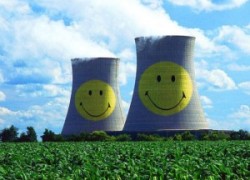
New Hampshire — Does nuclear energy deserve a seat at the table alongside renewable energy technologies in weaning us off of fossil fuels and transitioning into a cleaner energy world? A new report published yesterday suggests not only will newer small modular reactor (SMR) technology be at least as expensive as larger reactors, it won’t fit the needs of a more flexible grid system, and its development will siphon away funding from the truly renewable energy options that need it.
Few debates rile up the renewable energy sector, and our own readership, more than the issue of whether nuclear energy should have a starring role in our energy shift from fossil to clean technologies. Proponents point to its baseload functionality and lack of emissions; opponents rail against enormous costs, high-profile accidents and vast long-term impacts including what to do with the waste. Both sides rely on extensive subsidies to be viable, though at vastly different levels, and renewables (notably solar and wind) are quickly proving viable without them in an increasing number of markets. (At least neither side believes this Spurious Correlation.)
Yet analysis from international economic, climate change, and energy groups all reach the same conclusion: “Nuclear power is among the least attractive climate change policy options and is likely to remain so for the foreseeable [future],” says Dr. Mark Cooper, senior fellow for economic analysis at the Institute for Energy and the Environment at Vermont Law School, author of The Economic Failure of Nuclear Power and the Development of a Low-Carbon Electricity Future: Why Small Modular Reactors Are Part of the Problem, Not the Solution (PDF here, audio summary here). “Worse still, pursuing nuclear power as a focal point of climate policy diverts economic resources and policy development from critically important efforts to accelerate the deployment of solutions that are much more attractive: less costly, less risky, [and] more environmentally benign.”
Here’s why he says SMR nuclear not only isn’t part of the renewable energy equation, it actually undermines it:
- It won’t be cheaper. Like any significant technology leap SMR involves substantially more costs, from using more material per MW of capacity to establishing the infrastructure to design and build the reactors: up to $90 billion by 2020 to fund just two designs and assembly lines, he predicts. That’s three-quarters of the total projected investment in all electricity generation — and of course it’s far more than renewables’ slice of that pie. And the flip side of this coin is subsidies. For 60 years nuclear has been deeply reliant upon vastly more subsidies than renewables have received, and it’s still dependent upon them — except in the current scrutinous political climate many of the key ones for nuclear aren’t on the table, from liability insurances and waste management to decommissioning, water use, and loan guarantees.
- The strategy is bad. The aggressive deployment strategy being proposed for dozens of SMRs near population centers is reminiscent of the ‘Great Bandwagon Market’ of the 1960s-1980s when utilities ordered hundreds of reactors and ultimately cancelled more than half of them. That was followed by the ‘nuclear renaissance’ in the 2000s but only 10 percent of those planned reactors are under construction. Now SMR is in the spotlight, five years on and still on the drawing boards, with key developers Westinghouse and Babcock & Wilcox reigning in their SMR efforts (partly blaming low-cost natural gas) as they struggle to find customers and major investors. “It is always possible that nuclear power’s fairy godmother will wave her magic wand over the technology and solve its economic, safety, and environmental problems,” mused Cooper in an e-mail exchange, “but there is nothing in the 50-year history of commercial nuclear power that suggest this is anything but a fairy tale.”
- Safety is not first. Despite a raft of safety issues that SMR technologies have to overcome, proponents actually want pre-approvals, limited reviews, and reduced safety margins including staff and evacuation zones. With Fukushimastill in the headlines three years later, good luck getting policymakers and regulators to agree to de-emphasize safety — as long as we’re all reminded about it.
- What’s best for the future? The trend toward a more decentralized energy delivery system is the opposite direction from the passive one-way 24/7 baseload delivery model of a nuclear reactor. “Any resource that is not flexible becomes a burden on the system, rather than a benefit to it,” said Cooper.
Billing SMR nuclear technology as more flexible and cheaper than larger reactors is an even better argument to support non-nuclear renewable energy options unencumbered by the same security, proliferation, and environmental risks, Cooper points out. But giving nuclear power a central role in current climate change policy will “not only drain away resources from the more promising alternatives, it would undermine the effort to create the physical and institutional infrastructure needed to support the emerging electricity systems based on renewables, distributed generation and intensive system and demand management.”








